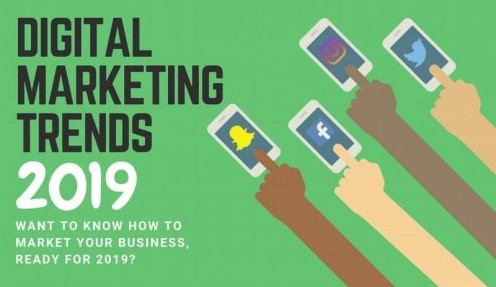3 Digital Marketing Trends Serious Freelancers Need to Adopt in 2019

I absolutely love reviewing marketing innovations, especially on a technological level. I find it quite interesting and valuable to learn "what's hot" and "what's cool."
Now, before we dig in, I would like to say that I wrote this article with freelancers and home-based businesses in mind.
I often get the notion that those who are self-employed figure marketing on a level beyond a Craigslist ad or a post on Facebook is too much for their “tiny” business.
The thing is, most brand name giants we know of today started out as a tiny business as well.
While “thinking outside the box” is what leads people to start their own small business, “thinking big” is what allows that small business to grow into a bigger one.
Though far from being a home-based business, Domino’s is an excellent example of a business that started relatively small and grew into an international chain.
It took the company 23 years to become an international brand.
Domino’s continued to grow and think about marketing in innovative ways, profiting greatly from advancements in digital technology and media.
In 2018, Dave Wild, the CEO of Domino's in the United Kingdom, spoke at the Technology for Marketing/E-Commerce Expo, stating that the UK-based Domino’s only started accepting pizza orders over the internet in 2010.
Back then, online sales only accounted for 30 per cent or less of the company's total revenue.
In 2018, Domino’s boasted it controlled 50 per cent of the UK's pizza market, while 80 per cent of its business came from digital transactions.
Over two-thirds of those sales come from smartphone applications.
In this article, I'll cover some examples of the latest digital marketing trends already employed by leading brands.
Most likely, these trends will trickle down and be adopted by small and medium-sized businesses as the year progresses. And, freelancers, that means you, too!
Furthermore, even though these trends mostly involve medium to large-sized companies, I believe freelancers and small home-based businesses should be ahead of the game in adopting such innovations.
So, let's get down to business.
1. Search Trends As It Relates to Marketing

As I've written in previous articles, Google dominates the SERP domain and, thus, it controls a significant portion of all marketable search engine results.
Therefore, this section only focuses on Google, since no one really cares about Bing, and Yahoo's algorithm focuses more on aged content rather than quality.
Additionally, it's important to remember that Google launched some of its most significant updates to date in August of last year, most of which will start affecting searchable content this year as these updates evolve.
The most enormous and obvious change that has so many marketers excited is the Google Marketing Platform.
This change led to AdWords being renamed to Ads, as well as more tightly integrated analysis tools such as Data Studio, Google Analytics, and AB testing.
You'll also see subtle changes in the DoubleClick Digital Marketing (DDM) platform.
In 2019, one organic search update to keep in mind is Google's Speed Update, which penalizes slow and sluggish websites.
Hopefully, it will work in favour of those who put a lot of energy (or money) into maintaining a fast site, since it was only released after Google put it through months of rigorous testing.
I mention that because sometimes it takes a while to work out the bugs in new updates of any kind, so monitor Google's forums concerning glitches or complaints so that you understand why you've started noticing any weird behaviour.
For example, Google’s Speed Update initially targets slow-running sites.
However, we who stay on top of digital marketing news expect Google to adjust the algorithm so that it affects more websites according to things such as not making site improvements within specified time frames.
Another thing not to overlook in 2019 is how Google's search snippets evolve.
The graph above shows the key features that will remain important to organic SERPS, such as questions, images, and featured snippets.
It's easy to see the importance of comprehending and answering your audience's queries in a more normal, conversational manner, which makes exact keywords not as crucial as before.
Conversational searches will become more accurate on smartphones and voice-activated smart speakers, such as Amazon's Eco or Google Home Max.
So optimizing your content in a way that works well with voice searches is essential in 2019.
You can see the chart also shows a nearly total switch to secure HTTPS among leading websites that are monitored and listed by Mozcast in its list of SERPS for 10,000 keywords most commonly used.
2. Ad Placement On Navigation and Map Applications

Nearly three years ago, Google posted an article entitled “Ads and Analytics Innovations for a Mobile-First World” pointing out there are trillions of searches conducted globally every year.
Over half of those searches are done using a mobile device.
Additionally, the article goes on to state, "across the millions of websites using Google Analytics today, we're seeing more than half of all web traffic now coming from smartphones and tablets."
If you're like a lot of people I know (including myself), then you would agree that a large percentage of searches done via mobile is while we're out and about searching for a business.
According to the Pew Research Center, around 77 per cent of Americans frequently use map and navigation applications. We will see these statistics rise in 2019, and these apps will become favourites among marketers as well.
It only makes sense that anyone who owns a brick and mortar business to have their business listed in Google Maps, including photos and a description of their products or services, and this is at the very least.
It's preferable that such businesses have a website.
Nothing compliments a nicely designed website like advertising on navigation apps so people can not only find you but also get to know you a bit.
How Popular are Map and Navigation Applications?
There is a reason why map and navigation applications have advertisers all giddy: they're very popular with anyone with a smartphone.
MDG Advertising states that eMarketer reported that over 67 per cent of smartphone owners open a map application once a month, at the least.
The data also shows map applications are opened 52 per cent more often than dating apps.
3. Content Marketing Will Become Even More Important

By its very nature, content creation is a B2B industry. The only reason any business wants to have quality content created is to represent their brand.
So, as a freelancer working in the content industry, you definitely want potential clients to see you as a master of your chosen field of expertise.
I like to compare it to an entertainer such as an actor or music artist. When they do their thing on the big screen or the stage, the vast majority of people are in awe of their talent and prowess.
They command their space like no other and, in some cases, they have no rivals even though they have counterparts as equally talented.
Even famous sports athletes didn't earn their fame by merely being a skilful player; these unique individuals also bring entertainment via their quirky, magnetic, and charismatic personalities.
As for the content marketing business, if you're a copywriter, it's crucial to follow this same frame of mind. Nothing annoys me more than reading content written by a copywriter who is a great technical writer yet lacks personality.
Even those writers who write in an upbeat, energetic tone often times sound too “salesy,” trying way too hard to sound like they know what their writing about even though they all but copied it from another article.
A Few Content Marketing Trends Still Relevant in 2019
It's time to get serious about commanding your space in the world of content marketing. Content is at the heart of the digital landscape, and it's visible to the entire world 24-hours a day, seven days a week.
As long as there is an Internet keeping people connected to this digital world, the content you create, whatever it is, could help thousands if not millions find or learn something valuable over time.
Brands have long recognized this, and this is why the following points are essential to remember.
- In 2019 and beyond, it will be important to try new content formats such as audio (podcasts), video (YouTube), and short stories (full of photos).
-
It’s time to start thinking about creating content for voice search more than written.
- The future of content marketing will be controlled by micro-influencers.
-
If click-bate hasn’t died by now, 2019 will be the year. Your content should be original and relevant or it’s not going anywhere.
- Brand storytelling will be an even bigger thing.
-
“Social shiny objects” syndrome will be cured by data-driven decisions.
This content is accurate and true to the best of the author’s knowledge and is not meant to substitute for formal and individualized advice from a qualified professional.
© 2019 Sarah Draper








